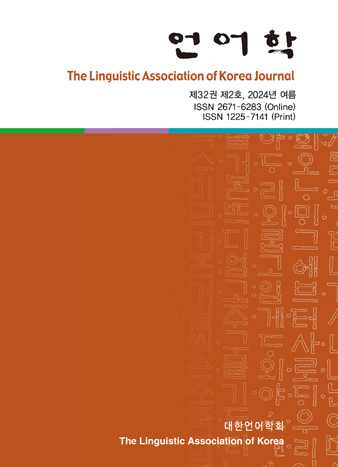대한언어학회 전자저널
32권 2호 (2024년 6월)
- 한국어 품사분류에서 감탄사의 통시적 분석
-
사하부트지노바 루이자 조이로브나
Pages : 49-71
Abstract
Sakhabutdinova, Luiza Zoirovna. (2024). A diachronic analysis of interjections in Korean part of speech classification. The Linguistic Association of Korea Journal, 32(2), 49-71. In this paper, I examine the historical development and the evolution of names and functions of Korean interjections based on word recognition and conceptual frameworks. I examine the criteria for word class classification found in grammar books, focusing on the grammar research achievements during the first period (1897-1933) and the second period (1934-1963) as covered by Koh Young Geun (2001). I analyze the logical progression by comparing the content of grammar books and textbooks from the first period (1897-1933) and the second period (1934-1963) up to the Unification of School Grammar in 1963. It has been established that the function of interjections and their placement in the word class hierarchy can vary based on how words are recognized and the criteria used for word class classification. Interjections can be defined in relation to other parts of speech, either as a subtype of another part of speech or as an independent category. For instance, when postpositional particles, endings, conjunctions, and similar elements are recognized as distinct parts of speech, the position of interjections in the word class hierarchy changes. Research has shown that the Korean parts of speech system has varied from up to 13 parts of speech to as few as 5, with some studies indicating that interjections were sometimes omitted from these classifications. In my study I examine the linguistic characteristics of interjections as a part of speech and their position within the Korean grammar system through a diachronic analysis.
Keywords
# 문법(grammar) # 체계(system) # 품사(word class) # 의미(meaning) # 기능(function) # 형태(form) # 명칭(name)
References
- 고영근 외. (2001). 역대한국문법의 통합적 연구. 서울대학교 출판부.
- 고영근, 이용, 최형용. (2011). (현대어로 풀어쓴) 주시경의 국어문법. 서울: 박이정.
- 구본관. (2010). 국어 품사분류와 관련한 몇 가지 문제, 형태론, 12(2), 179-199.
- 구본관 외. (2015). 한국어 문법 총론. 1, 개관, 음운, 형태, 통사. 서울: 집문당.
- 金東鉉. (1998). 국어 품사분류 연구, 論文集, 10(1), 23-52.
- 김석득. (1983). 우리말 연구사, 서울: 정음문화사.
- 김석득. (2009). 우리말 연구사: 언어관과 사조로 본 발전사. 파주: 태학사.
- 남기심, 고영근. (1985/1993). 표준 국어문법론. 서울: 탑출판사.
- 서일홍. (1976). 문법 교과서의 당면문제: 중학교 검인정교과서를 중심으로, 이화여자대학교 교육대학원 석사학위논문.
- 서태룡. (1992). 국어 감탄사에 대하여, 동악어문논집, 34, 7-36.
- 이익섭. (2005). 한국어 문법. 서울: 서울대학교출판부.
- 주시경 저; 고영근, 이용, 최형용 (공)교주. (2010). 주시경 국어문법의 교감과 현대화, 서울: 박이정.
- 채완. (2011). 일석 이희승 선생의 학교 문법 체계, 애산학회, 37, 133-160.
- 최현배. (1955). 우리말본/깁고고침[판]. 서울: 정음사.
- 최현배. (1971). 우리말본/4번째고침[판]. 서울: 정음사.
- 최현배. (1999). 우리말본/열여덟번째[판]. 서울: 정음사.
- 최형용. (2010). 품사의 경계, 한국어학, 47, 61-92.
- 최형용. (2012). 분류 기준에서 본 주시경 품사 체계의 변천에 대하여, 국어학, 63, 313-340.
- 최형용. (2013). 한국어 형태론의 유형론. 박이정.
- 최형용. (2015). 안확(1917) 조선문법, 경성: 유일서관, 2+3+87면, 142-158.
- 최형용. (2016). 한국어 형태론. 서울: 역락.
- 金敏洙, 高永根 [공]編. (2008). 歷代韓國文法大系. 第1部 第37冊/第2版, 서울: 博而精.
- 허재영. (2001). 감탄사 발달사. 한국어 의미학, 9, 65-96.
